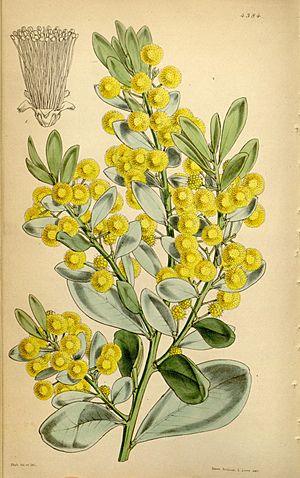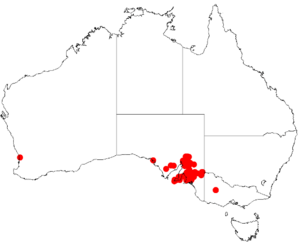Silver mulga facts for kids
Quick facts for kids Silver mulga |
|
|---|---|
 |
|
| Illustration of Acacia argyrophylla | |
| Scientific classification | |
| Genus: |
Acacia
|
| Species: |
argyrophylla
|
 |
|
| Occurrence data from AVH | |
The Silver Mulga (Acacia argyrophylla) is a type of Acacia plant. It's a shrub that grows naturally in South Australia. People call it "silver mulga" because of its pretty, silvery leaves.
What Does Silver Mulga Look Like?
The Silver Mulga is a shrub that stands up straight. It grows to be about 2 to 3 meters (6.5 to 10 feet) tall and wide. Its branches have bright greenish-yellow hairs.
Its leaves are actually not true leaves! They are flattened leaf stems called phyllodes. These phyllodes are silver-blue-grey and shaped like a spoon. They are about 2.5 to 5 centimeters (1 to 2 inches) long.
This shrub produces groups of flowers called inflorescences. These flower clusters have 25 to 45 flowers on each head. They are covered in dense, golden-green hairs.
After the flowers, the plant grows dark brown seed pods. These pods are long and thin, about 10 centimeters (4 inches) long. They can be rough or bumpy over the seeds. Inside the pods are black, oval-shaped seeds. Each seed is about 7 millimeters (0.3 inches) long.
Naming the Silver Mulga
The Silver Mulga was first officially described in 1848. A botanist named William Jackson Hooker gave it its scientific name.
Later, in 2003, another botanist, Leslie Pedley, changed its name to Racosperma argyrophyllum. But in 2006, it was moved back to the Acacia group.
The name argyrophylla comes from two ancient Greek words. "Argyros" (ἄργυρος) means silver, and "phyllon" (φύλλων) means leaf. This name perfectly describes its silvery leaves!
Where Does Silver Mulga Grow?
The Silver Mulga is only found in South Australia. You can see it in places like Hawker in the Flinders Ranges. It also grows south near Monarto.
Other groups of these plants are found on the Yorke Peninsula. You can also spot them around Onkaparinga Gorge. Silver Mulga often grows on slopes and low hills. It is usually part of open woodlands and mallee plant communities.

